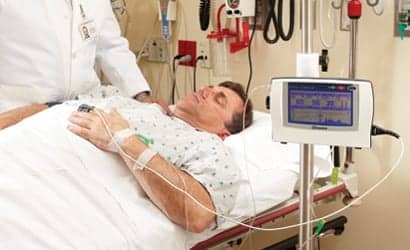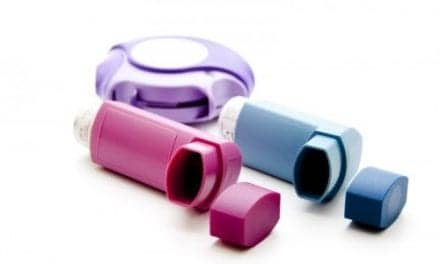 |
The National Institutes of Health estimates that there are approximately 12 million people diagnosed with chronic obstructive pulmonary disease (COPD) in the United States and another 12 million people who are undiagnosed. Research involving long-term oxygen therapy (LTOT) has demonstrated that home oxygen therapy decreases morbidity and mortality for COPD patients, and it has been anecdotally shown that it enhances their quality of life. It is currently estimated that approximately 1 million patients are using home oxygen therapy in America today. Several different methodologies to provide home oxygen therapy have evolved over the past 25 years based on factors such as oxygen liter flow, ambulatory needs outside of the patient’s residence, manual dexterity of the patient, and reimbursement. Continuous oxygen therapy usage based on claims paid by Medicare in 2006 shows the breakdown of current methodologies being used:
- 85% oxygen concentrator with compressed gas cylinders for ambulation;
- 9% liquid oxygen stationary with liquid portable;
- 6% deliveryless oxygen system, either portable AC/DC/battery-operated concentrators or concentrators with systems to fill compressed gas cylinders or liquid oxygen vessels.
Currently, the choice of systems for home use is determined by the durable medical equipment (DME) provider in collaboration with the prescribing physician and the patient. While not all available oxygen systems are appropriate for a specific patient, the vast majority of home oxygen users can have their clinical respiratory care needs met with the majority of the manufacturers’ products within the three types of ambulatory systems available. Higher oxygen liter flows are generally the factor that limits choice based on clinical needs of the patient. The lifestyle needs of the patient are currently moving the industry to provide smaller and lighter ambulatory systems. With oxygen therapy being prescribed earlier in the disease process, a more mobile patient is being seen. Oxygen conservation devices are employed today with compressed gas cylinders, liquid oxygen portable vessels, home fill systems, and portable oxygen concentrators. Cost of acquisition, existing reimbursement, and lifestyle of the patient often are factors that determine the home oxygen system a patient receives.
Oxygen Concentrators
Oxygen concentrators are devices that use ambient air pumped through either banks of molecular sieves or a semipermeable membrane that preferentially separates the oxygen and nitrogen. These devices deliver a continuous flow of oxygen with a purity of greater than 90%. While concentrators do not deliver pure oxygen, it has been demonstrated that the concentrator equally meets the clinical needs of the patient when compared to pure oxygen. Advances in technology have greatly improved the reliability of these devices. Twenty years ago, most manufacturers recommended that the oxygen concentrator’s purity be checked on a monthly basis. Today, purity check recommendations range from every 6 months to once per year depending on the manufacturer. Concentrators that continually monitor their purity when in use and notify the patient when purity falls below an acceptable level are available. The traditional oxygen concentrator does not provide any portability and does have some limitations within the residence. The system is generally centrally located within the home, and a maximum of 50 feet of oxygen supply tubing with a nasal cannula can be attached to the concentrator. Homes in the United States have been increasing in square footage over the past few decades, and in many residences the need to be within 50 feet of the oxygen concentrator and the ability to get to every room in the residence can present a challenge.
Concentrator patients are provided with a number of compressed oxygen cylinders or a liquid system for ambulation in the community. The cylinder size and number of cylinders are generally based on the average time patients are outside their home, liter flow, and ability to use a conservation device. Cylinder delivery varies from weekly to monthly, depending on how frequently patients leave their houses, distance between the residences and the DME providers, and the policies of the providers. Historically, these patients were discouraged from using their limited supply of compressed gas cylinders within their home. Backup oxygen separate from their ambulatory oxygen cylinder supply is maintained for any electrical or mechanical failure.
Liquid Oxygen
Liquid oxygen systems have been available for several decades. These systems employ a stationary vessel, which is placed in the home, and a portable vessel, which can be filled from the stationary system. Stationary vessels are manufactured in several sizes, and the size of the device placed in a residence is determined by liter flow, approximate number of times per week the portable vessel is filled from the stationary system, and the frequency with which the DME provider anticipates visiting the patient to refill the stationary system. When using liquid oxygen, a certain amount of oxygen is lost to the atmosphere as the liquid warms within the stationary and portable systems. As pressure builds within the container, oxygen is vented out of the system to maintain the appropriate pressure; as the design of the stationary and portable containers improved, the loss of oxygen to the atmosphere has decreased. Portable vessels now have the capability of holding oxygen up to 24 hours, while in the past any oxygen not consumed by the patient was generally vented out of the system within 8 hours. Liquid oxygen has the advantage over other portable systems in that it can provide a higher liter flow. Liquid portable systems are available in several sizes and weights to meet the needs of a wide variety of patients. Oxygen concentrators that can provide up to 10 lpm are available for use as a stationary system in a residence, but providing an ambulatory system for the high-flow oxygen patient is a challenge. Currently liquid oxygen is the only option to provide the high flow oxygen patient an acceptable weight and duration of usage in the community. Higher flow oxygen therapy patients by and large have difficulty in maintaining appropriate oxygen saturation with activity when using an oxygen conservation device. Liquid oxygen provides for increased ambulation within the residence as well, by allowing the patient to fill their portable vessel at any time and use it within the residence to reach areas where 50 feet of oxygen supply tubing will not suffice. Anecdotally, some patients prefer liquid oxygen to other systems because it does not create any noise or heat or consume any electrical power.
Deliveryless Systems
Deliveryless oxygen systems are the newest approach to meeting the needs of ambulatory oxygen patients. Deliveryless systems fall into two categories: systems that fill compressed gas cylinders in the residence and the portable oxygen concentrator. The self-filling systems utilize gas from an oxygen concentrator and fill the compressed gas cylinder over a period of time. The time these systems take to fill the cylinder depends on the size of the cylinder and can be from 1 hour to several hours. This can be a disadvantage when compared with a liquid oxygen system, which fills the portable within minutes; but with appropriate planning, this can be overcome. Appropriate education regarding approximate fill times for the specific cylinder sizes is essential. A plus for the home-fill systems is that it allows patients to use their self-filled cylinders within their residences. They have the ability to safely fill cylinders while they are sleeping or away from their residences, and they can choose different cylinder sizes that meet their lifestyle needs. Regulators are built into the compressed gas cylinders because oxygen concentrator gas has purity between 90% and 95%, and under the FDA regulations, pin and diameter-safety indexed oxygen regulators are for pure oxygen only. This can be an advantage for the home-fill systems in that some patients, due to vision issues or arthritis, have difficulty moving the oxygen regulator between compressed gas cylinders. Published studies have indicated that concentrator-filled cylinders are clinically equivalent in meeting the needs of the home oxygen patient when compared to compressed gas cylinders with pure oxygen.
Portable Systems
Portable oxygen concentrators (POCs) are manufactured by several companies. The sizes and weights of these devices vary from as light as 5 pounds to as heavy as 17 pounds. The heavier portable oxygen concentrators have carts or built-in wheels to improve their portability. Some of the portable oxygen concentrators have been designed to operate as the patient’s stationary and portable oxygen systems, while others have been intended to be an ambulatory system only. The battery life of a POC should be evaluated to ensure that the device will meet the lifestyle needs of the patient. Generally, the higher the oxygen liter flow at which the device is operated, the shorter the life of the battery power available for usage in the community. Battery life between devices varies from 45 minutes up to 4 hours at 2 LPM. The POC can be powered from the standard power outlet in a motor vehicle as well to save battery life for use in the community. The majority of POCs operate using only an oxygen conservation device. One portable system on the market has the ability to provide continuous flow when it is plugged in. There has been some research that has demonstrated that oxygen conservation technology can be used when sleeping, if the patient does not experience any apneas. The selection of an appropriate POC should be based on the liter flow of the patient, length of time the patient will be away from a power source on a regular basis, whether acceptable oxygen saturation can be titrated with ambulation, and ability to use the system nocturnally if the system is to be utilized while sleeping. The Federal Aviation Administration has approved a number of the POCs for use on commercial airlines, but each airline has the ability to set its own polices regarding POCs.
Conclusion
The trend has been toward smaller and lighter ambulatory oxygen systems, but every system available will not meet the needs of every patient. A clinician should titrate an oxygen system that uses oxygen conservation technology to ensure that a patient is demonstrating adequate oxygen saturation at rest and with activity. A system should not be selected solely on weight or battery life. Smaller and lighter is not superior if the system does not meet the needs of the patient.
 |
Editor’s note
Read more about oxygen systems
Technology is advancing very swiftly. The standard of practice today is different from that of a decade ago and will be different from the standards in the future. A work-in-progress might be the best description of what is available to meet the ambulatory oxygen needs of the patient today. As new devices become available, the respiratory care professional must evaluate to ensure that the clinical needs of the patient are being met while taking advantage of what new technology can offer in smaller and lighter devices that provide longer use when patients are out in the community.
James P. Stegmaier, RRT-NPS, RPFT, CCM, is director of Allegiant Medical Equipment Inc, Lorain, Ohio. For more information contact [email protected]









